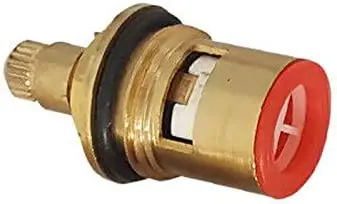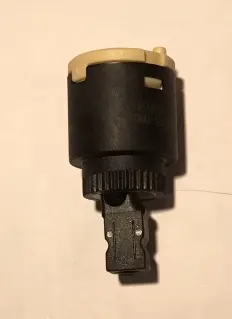A faucet cartridge is an essential component of both kitchen and bathroom faucets, working as the primary mechanism to handle regulating the water flow. For homeowners and professional plumbers who are working in plumbing or faucet maintenance, understanding how a faucet cartridge works is crucial.
The faucet cartridge is made up of a number of parts, each of which is essential to its overall performance. This article will explain the complex workings of a faucet cartridge and give a step-by-step breakdown of how it functions.
What Is The Faucet Cartridge?

A faucet cartridge is a part of the faucet that can be found in various faucets. It is a removable part and controls the temperature, pressure, and water flow.
The water flow and temperature can be opened and closed as well as adjusted using the rubber and metal pieces found in the cartridge.
The cartridge in a faucet moves as the handle is cranked, either allowing water to flow through or totally closing it off. Replacing the cartridge is frequently the fix for leaks or temperature control problems with a faucet.
Typically, the cartridge is made of sturdy materials like ceramic, plastic, or metal. It has several channels, seals, and apertures that make it easier to flow and regulate water. Depending on the type and brand of faucet, the cartridge’s precise configuration and design may change.
Different Parts of The Cartridge

A faucet cartridge consists of several parts that work together to control the flow of water. Understanding these parts will provide insight into how the faucet cartridge operates.
- Body – The cartridge’s body is often constructed of brass or another strong material. It holds the other components and is linked to the faucet handle and spout.
- Stem – The stem is a primary component that extends from the cartridge’s body to the handle. It is in charge of conveying the rotating action of the handle to the cartridge, allowing the water flow to open and close.
- O-rings – O-rings are rubber gaskets that form a watertight seal between several cartridge components. They ensure seamless functioning and the prevention of leaks.
- Seals – Seals, which are often referred to as washers or discs, are essential for regulating water flow. Typically constructed of rubber or ceramic, they assist in controlling the opening and closing of water passages inside the cartridge.
- Inlet and Outlet Ports – The cartridge’s inlet and outlet ports are the openings through which water enters and escapes. The cartridge can regulate the flow and temperature of the water because they are attached to the water supply lines.
How Faucet Cartridge Controls Water Flow?
Controlling the flow of water from a faucet depends heavily on the faucet cartridge. The handle’s rotation causes the stem holding the cartridge to revolve.
The seals or discs inside the cartridge rotate as a result, opening or closing the water channels as a result.
The cartridge controls how much water can flow through the faucet by moving the seals in different directions.
In order to obtain the desired temperature, it also controls the hot and cold water mixture. Water flow may be controlled precisely and smoothly thanks to the cartridge’s seals’ thoughtful design and positioning.
Types of Faucet Cartridge
Faucet cartridges come in different types, each with its own design and mechanism for controlling water flow. The most common types include:
Compression Cartridges

The conventional type of cartridge seen in older faucets is compression. They regulate the flow of water using rubber seals or discs. The seals are forced against the water entrance when the handle is twisted, either preventing or allowing water to enter through.
Ceramic Cartridges

Modern faucets frequently use ceramic cartridges because of their dependability and durability.
To regulate water flow, they use ceramic discs that move past one another. The discs align to either generate or obstruct water channels as the handle is rotated, providing accurate temperature and flow control.
Ball Cartridges

Ball cartridges are frequently used in faucets with a single handle. They have a spherical ball with holes for the inlet and outflow.
By moving the ball and aligning the perforations, the handle rotates to regulate water flow and temperature. Ball cartridges are known for their durability and smooth functioning.
Disc Cartridges

Ceramic and ball cartridge design features are combined in disc cartridges. To control water flow, they have mixing chambers with rubber gaskets that slide against one another. These cartridges provide consistent performance and precise temperature regulation.
How Does a Faucet Cartridge Work?
A lever or knob attached to the cartridge is activated when the faucet handle is turned on. The cartridge in the faucet body rotates or slides as you adjust the handle. This movement lines up the cartridge’s openings or ports with the water supply lines that are attached to the faucet.
Water is permitted to pass through the cartridge and out of the faucet spout when the cartridge openings match up with the water supply lines.
Within the cartridge, water travels through internal channels that are intended to control the flow rate and maintain constant pressure.
The cartridge simultaneously regulates how hot and cold water are mixed. The cartridge travels inside the faucet body to control the amount of hot and cold water entering the cartridge as you turn the handle to the temperature you choose. You can change this so that the water at the faucet spout is the desired temperature.
Seals and gaskets inside the cartridge are positioned carefully to stop leaks and guarantee that water only travels via the intended channels. These seals keep the cartridge apertures airtight, preventing water from escaping in unintended ways.
When you turn off the faucet, the cartridge returns to its closed position. This closing action stops the flow of water entirely, thanks to the seals within the cartridge effectively blocking the passage of water. This ensures that no water continues to drip or leak from the faucet when it’s not in use.
Advantages of Faucet Cartridges

Improved Durability and Longevity of Faucet
Compared to conventional faucet mechanisms, faucet cartridges are made to be more durable and long-lasting.
The cartridge is built to withstand repeated usage and resist wear and tear, whether it is made of ceramic, rubber, or another material. Tap cartridges can withstand the challenges of regular usage without readily breaking or malfunctioning because of the use of premium materials and careful engineering.
Cartridges provide a more dependable and long-lasting solution than earlier faucet designs that depended on washers and seals that can deteriorate with time. The lifespan of the faucet is increased by lowering the likelihood of leaks and drips caused by the removal of rubber washers and other perishable components.
The increased longevity not only reduces the cost of maintenance and replacements but also gives homeowners peace of mind.
Enhanced Water Efficiency and Conservation
Cartridges for faucets aid in efforts to conserve water and increase water efficiency. They are made to precisely regulate water flow, enabling users to attain the required water pressure and reduce waste. Users can save water by lowering needless usage if the flow rate can be accurately adjusted.
Additionally, some faucet cartridges include extra features like flow restrictors or water-saving aerators.
By lowering the amount of water that flows through the faucet without affecting its functionality or user experience, these technologies further reduce water usage. Water-saving faucet cartridges support environmental sustainability and over time can assist reduce water costs.
Smooth and Precise Water Temperature and Flow Control
The ability to manage water temperature and flow smoothly and accurately is one of the major benefits of faucet cartridges.
The cartridge’s internal mechanisms, such as ceramic discs, ball bearings, or rubber seals, enable fluidic changes in the temperature and flow of the water.
Creating a proper balance between hot and cold water using conventional faucets, was frequently difficult.
However, faucet cartridges give users a simpler way to easily adjust their preferred temperature since they offer more precise control over the mixing of hot and cold water.
How Does a Faucet Cartridge Fail?
- The internal cartridge components may corrode or wear out over time as a result of the cartridge’s continuous use and exposure to water. This may result in leaks, decreased water flow, or trouble regulating the water pressure and temperature.
- Water frequently contains minerals that might build up inside the cartridge, preventing it from moving freely or making it stiff and challenging to use. This could lead to a trapped or broken cartridge.
- Due to aging or heavy use, the O-ring, which creates a watertight seal, might become worn, cracked, or broken. Leaks near the cartridge can result from the O-ring failing.
- The cartridge may break down too soon if it is not installed properly or if it is not compatible with the faucet model. Cartridge failure might be caused by poor alignment, insufficient sealing, or excessive force used during installation.
- A cartridge could occasionally have production flaws including subpar materials or malfunctioning parts. These flaws may result in the cartridge failing too quickly or showing issues right away after installation.

James Lewis is a seasoned plumber and faucet enthusiast who shares his expertise on Faucetsavvy.com. With over 15 years of experience in the plumbing industry, he’s passionate about helping homeowners find the perfect faucet for their needs. He’s also dedicated to empowering DIY enthusiasts with the plumbing knowledge and skills needed to repair and maintain their faucets.
Recommended By Faucetsavvy's Team
Best Kitchen Faucets of 2025: Sleek, Durable & Worth Every Penny Check Our Review

